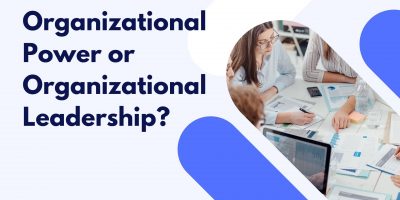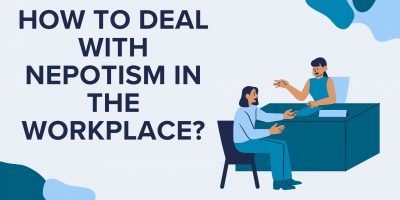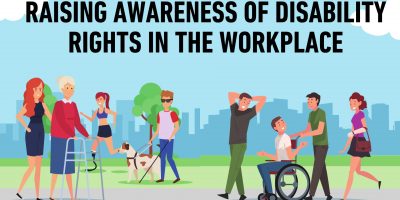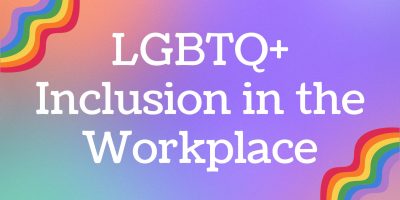
Organizational Power or Organizational Leadership?
What’s better, organizational power or organizational leadership? And can we have one without the other?

Unconscious bias is an unavoidable part of human existence and behavior. As uncomfortable as it can be to admit – everyone harbors unconscious biases and inevitably brings them into the workplace.
However, unconscious bias in the workplace can hinder diversity, recruiting, and retention efforts and unintentionally shape an organization’s culture. It affects who gets hired, promoted, and advances in the workplace.
HR leaders and senior management must ask the question, “To what extent are the organizational culture and business outcomes affected by unconscious bias?” In this article, we will discuss the consequences of unconscious bias, the different types of unconscious bias, and how to overcome it.
Most employees have probably heard the term “unconscious bias” from their HR department during their orientation, but they may not have had much opportunity to learn more about it.
So, what is unconscious bias in the workplace?
Unconscious bias, often called implicit bias, in the simplest sense, means having some prejudice towards another person. It is a learned belief, assumption, or attitude that exists outside of a person’s conscious awareness.
Over time, scientists have found that our minds are naturally wired to form assumptions and associations as a means of processing information more efficiently. Although we like to believe that we are open-minded and objective, the reality is that every individual has these biases that serve as mental shortcuts for faster information processing.
In other words, we all judge people or situations without being fully aware.
These hidden biases, shaped by our upbringing, cultural conditioning, and personal experiences, can unknowingly influence our judgments, decisions, and interactions, often resulting in unintended discrimination.
Discrimination often happens based on other people’s race, ethnicity, age, gender, appearance, sexuality (and more), and such behaviors can be particularly detrimental in the workplace, both to the groups of people they affect and the organization.

“Don’t judge a book by its cover.” This old adage is as relevant today as it ever was. We live in a world where people constantly judge each other, often based on stereotypes and biases.
As a result, unconscious bias can seep into the workplace in many ways – from treating people differently based on their clothes to rating overweight employees lower in performance evaluations.
For example, a survey conducted among hiring managers revealed that being overweight can significantly affect a woman’s chances of career advancement. When presented with images of women varying in body types, only 15.6 percent of the hiring managers expressed willingness to hire the woman with the largest body. Additionally, 21 percent of respondents labeled her “lazy” and “unprofessional.”
On the other hand, tall men have a significant career advantage. In fact, it was calculated that an inch of height is worth about $789 per year in salary – and that company presidents, CEOs, and military leaders were all taller on average.
Moreover, these biases persist not only in visible attributes, such as body size or height but also in less obvious factors, like the name on a resume. One study found that resumes with white-sounding names were more likely to be called back for interviews than resumes with African American and Asian-sounding names, even when the resumes were identical.
Is this type of bias rarely encountered in the workplace?
Here are some statistics on the prevalence of unconscious bias in the workplace:
These statistics show that unconscious bias is a pervasive problem in the workplace.
Needless to say, unconscious bias is a complex issue. As it’s hidden from our conscious awareness, it can be challenging to identify or understand it.
However, we know there are over 150 identified types of unconscious biases in the workplace, making eliminating them daunting. Below is a list of some which are more pervasive in the workplace.
|
Bias |
Definition |
Example |
|
Affinity Bias |
Favoring individuals who are similar to ourselves or have similar backgrounds, leading to preferential treatment. |
Promoting or hiring someone simply because they share the same alma mater or social interests rather than based on merit alone. |
|
Ageism |
Discriminating against individuals based on their age, leading to assumptions about their abilities or relevance. |
Assuming that an older employee is resistant to change and unable to grasp new technologies without considering their expertise. |
|
Appearance/ Pretty privilege |
Forming an overall positive or negative impression of a person based on their appearance. |
Managers may be less inclined to employ someone with tattoos. |
|
Authority Bias |
Granting more credibility or trust to individuals in positions of authority or power, leading to unequal treatment. |
Automatically accepting the ideas or decisions of a senior executive without questioning them, even if there are valid concerns or alternative solutions. |
|
Confirmation Bias |
The tendency to seek information that confirms preexisting beliefs or assumptions. |
A hiring manager with a strong preference for a particular candidate may unknowingly ask them easier questions highlighting their strengths instead of exploring areas where they may have weaknesses. |
|
Conformity Bias |
The tendency to adopt the beliefs and behaviors of a group without critical evaluation, suppressing diverse ideas. |
A teammate doesn’t ask for help on an assignment because they haven’t seen anyone else do that. |
|
Halo Effect |
Forming an overall positive impression of a person based on one positive trait. |
Assuming that a physically attractive individual must also be intelligent and capable without considering other factors. |
|
Horns Effect |
Forming an overall negative impression of a person based on one negative trait. |
Dismissing a colleague's suggestions or ideas because they made a mistake in the past without considering their other contributions. |
|
Name Bias |
Discriminating against individuals based on their names. |
During recruitment, discriminating against certain candidates if they don’t have an Anglo-sounding name. |
Our unconscious brain is constantly looking for patterns in the world around us. When we see two things happening repeatedly, our brain starts to expect them to occur together in the future.
For example, if we see many male senior managers and many female nurses, our brain may expect all senior managers to be male and all nurses to be female.
These mental shortcuts and labels stem from our evolutionary need to distinguish between friend and foe, a crucial skill that aided human survival.
In his book Thinking, Fast and Slow, Daniel Kahneman proposes the idea that our minds operate between two modes of thought: System 1 and System 2. System 1 is intuitive, fast, and automatic. System 2 is slower, more logical, and more deliberate.
Unconscious bias arises when we multitask, work under pressure, or need to quickly form judgments – in other words, when we heavily rely on System 1. While our conscious minds can process a mere 40 pieces of information per second, our unconscious minds have an astonishing ability to process a staggering 11 million pieces of information.
However, it is important to be aware that shortcuts can often lead to more problems than they solve. If left unchecked, our biases are simply a slippery slope to prejudice and discrimination.
Researchers at Harvard have created Project Implicit, a virtual laboratory where individuals can take various tests to learn how to identify and get educated about their biases.
In the workplace, the first step to eliminating bias is to be able to identify it, and there are specific steps leaders can take:
The structures and processes used to identify biases will vary from workplace to workplace, but the benefits of doing so are clear. Once we acknowledge that we all have unconscious biases, we can take steps to mitigate their impact on our decision-making.

Below are some examples of how unconscious bias can manifest in your workplace:
After reading these examples, you might think your workplace is immune to bias and discrimination. After all, you’ve never seen anyone being mistreated because of race, gender, religion, or sexual orientation.
But discrimination can be subtle, and it can be hard to spot. Even if you don’t see it happening, it doesn’t mean it’s not happening.
One of the most insidious ways that bias creeps into the workplace is through daily assessments of employee potential.
For example, an employee who is seen as being more “likable” or “professional” may be more likely to get good assignments and praise from senior management. And when they make mistakes, they may be more likely to be forgiven. On the other hand, another employee may get the less desirable assignments and be more harshly scrutinized for their mistakes.
These seemingly minor differences can accumulate over time and reduce equal opportunities, ultimately determining who gets promoted to leadership positions.
Unconscious bias is universal and impacts the workplace at all levels.
A striking example of the impact of unconscious bias is the persistent wage gap. On average, women are paid 82 cents for every dollar men earn, indicating a substantial disparity. This gap becomes even more pronounced when considering women of color, as they face a wider wage discrepancy.
According to a Deloitte survey, a staggering 84% of respondents said that bias adversely impacts their happiness, confidence, and overall well-being to varying degrees.
This issue is further highlighted by a 2017 study conducted by Harvard Business Review, which revealed that individuals, regardless of gender, experience differential treatment in the workplace, even when exhibiting similar behaviors such as speaking up in meetings, collaborating with colleagues, and engaging with leaders.
Amidst a disengaged workforce, biases can evoke feelings of isolation, frustration, and resentment among employees. In fact, research indicates that 33% of employees who perceive bias experience a recurring sense of alienation in their workplace.
Moreover, a staggering 70% believe that the bias they have personally encountered or witnessed has had a detrimental effect on their level of engagement at work. These biases and the accompanying microaggressions often contribute to a high turnover rate, as employees increasingly seek opportunities in organizations that prioritize inclusivity and provide a superior employee experience.
Bias in the workplace can limit the company’s ability to attract and retain top talent. A notable 31% of employees who perceive bias plan to leave their current employer within the year, and 80% of employees who perceive bias wouldn’t recommend their employer to people in their networks.
A considerable 34% of employees who perceive bias have withheld their ideas or solutions within the past six months. By making assumptions about someone’s working style, age, or interests, we risk stifling innovation by failing to recognize and appreciate the distinct contributions that each individual can bring.
As much as 68% of employees reported that bias had a negative impact on their productivity. The cost of unconscious bias in the workplace is projected at $64 billion annually. This includes the costs of replacing employees who leave due to discrimination, legal expenses, and lost productivity.
Clearly, unconscious biases have far-reaching effects, hindering decision-making, influencing team dynamics and productivity, and constraining company diversity.
What can be done about it?
In recent years, there has been a growing recognition and heightened awareness of the need to address unconscious bias in the workplace, and HR leaders are playing a key role in this effort.
Education and training programs aimed at addressing unconscious bias have seen a rise due to public outrage over racist incidents at work and growing evidence highlighting the harmful effects of employees feeling excluded.

Due to its inherent nature, bias has historically been challenging to define, teach, and reform. Traditionally, businesses have addressed unconscious bias with brief training sessions during onboarding. However, these sessions are often ineffective, as they are one-off events that do not provide employees with the opportunity to learn and grow over time.
In order to be effective, HR leaders need to take a more involved, ongoing approach with a growth mindset to tackle unconscious bias.
It requires a delicate balance of asking difficult questions, being thoughtful, and keeping an open mind regarding our own biases and those that occur around us daily. Continuous training is necessary to apply anti-bias principles and take action in our living, working, and learning environments.
The good news is that the majority of today’s workforce recognizes the value of initiatives aimed at fostering an inclusive working environment.
According to The Wall Street Journal, 20 percent of large US companies currently provide unconscious bias training to their employees. This number is expected to rise to 50 percent within the next five years.
Increasing diversity in the workplace brings a range of additional benefits, including:
It is evident that organizations must take action to address unconscious bias and foster diversity and inclusion, as doing so not only aligns with ethical values but also yields tangible benefits for both employees and the company’s overall success.
The bad news is that unconscious bias is hard-wired, and everyone has it. But the good news is that it is something that can be improved.
So, how to overcome unconscious bias in the workplace?
Implementing systemic changes at an individual level can be challenging. However, as a leader, manager, or even as a colleague, numerous actions can be taken to overcome bias effectively:
Equality is a fundamental human right, and it is something that we should all strive for. Therefore, recognizing and acknowledging our inherent biases is the first step toward fostering a truly inclusive workplace.
Although progress may not happen overnight, it is imperative for organizations to actively address unconscious bias in the workplace head-on. By implementing proactive measures, they can pave the way for positive changes and, ultimately, a transformed workforce. The benefits of such initiatives are far-reaching, extending beyond mere statistics or compliance.
Senior Content Writer at Shortlister
Browse our curated list of vendors to find the best solution for your needs.
Subscribe to our newsletter for the latest trends, expert tips, and workplace insights!

What’s better, organizational power or organizational leadership? And can we have one without the other?

How can organizations effectively address and navigate cases of nepotism? Is it possible to rectify the damage caused and restore trust within the workforce?

Transform your workplace with actionable strategies to foster inclusivity, accommodations, and advocacy for employees with disabilities.

Creating a safe and inclusive society is impossible when the workplace does not reflect that. Thus, corporate America has some catching up to do when it comes to LGBTQ+ inclusion in the workplace.
Used by most of the top employee benefits consultants in the US, Shortlister is where you can find, research and select HR and benefits vendors for your clients.
Shortlister helps you reach your ideal prospects. Claim your free account to control your message and receive employer, consultant and health plan leads.